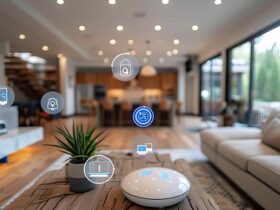Smart home technology has revolutionized the way we live, offering convenience, efficiency, and enhanced security. By integrating advanced systems into our daily routines, we can streamline various aspects of our lives, making everything from controlling lighting to securing our homes simpler and more efficient. Here, we explore 7 ways smart home technology can simplify your life.
1. Effortless Home Automation
Automate Daily Tasks
With smart home technology, mundane daily tasks can be automated, freeing up valuable time. Systems like smart thermostats, lights, and coffee makers can be programmed to follow your schedule, ensuring that your home environment is always just the way you like it.
Voice-Activated Assistants
Voice-activated assistants like Amazon Alexa, Google Assistant, and Apple’s Siri make managing your home easier than ever. These devices allow you to control smart appliances, play music, set reminders, and even answer questions with simple voice commands.
2. Enhanced Home Security
Smart Security Systems
Smart security systems provide real-time monitoring and alerts, helping you keep an eye on your home from anywhere in the world. Features like motion sensors, doorbell cameras, and smart locks enhance your home’s security by deterring intruders and notifying you of any suspicious activity.
Remote Monitoring
With smart security cameras, you can monitor your home remotely via your smartphone. This capability ensures that you are always aware of what’s happening at home, whether you’re at work or on vacation.
3. Energy Efficiency and Cost Savings
Smart Thermostats
Smart thermostats like Nest and Ecobee learn your schedule and preferences, adjusting the temperature to optimize energy usage. This not only creates a comfortable living environment but also helps reduce energy bills.
Automated Lighting
Smart lighting systems, such as Philips Hue, allow you to control your lights remotely, set schedules, and even adjust brightness and color. This can significantly reduce electricity consumption by ensuring lights are only used when needed.
4. Convenience in Home Management
Integrated Home Hubs
Smart home hubs like Samsung SmartThings integrate various smart devices into a single platform. This centralized control simplifies the management of your smart home, making it easier to operate multiple devices simultaneously.
Smart Appliances
From refrigerators that notify you when groceries are running low to washing machines that can be controlled remotely, smart appliances bring a new level of convenience to home management. These devices often come with advanced features that improve their efficiency and ease of use.
5. Improved Entertainment Options
Smart Entertainment Systems
Smart TVs and streaming devices provide access to a wide range of content with just a few clicks. Voice-controlled remotes and integration with home assistants mean you can quickly find and play your favorite shows, movies, and music without fumbling through multiple remotes.
Multi-Room Audio
Smart speakers and audio systems, such as Sonos, offer seamless multi-room audio, allowing you to play music in any room with high-quality sound. Control is easily managed via a smartphone app or voice commands, making it simple to enjoy your favorite tunes throughout your home.
6. Personalized Living Experiences
Customized Lighting and Ambiance
Smart home technology enables you to create personalized living spaces with customized lighting and ambiance settings. Whether you want to set the mood for a romantic dinner or create a productive workspace, smart lighting and shading solutions can be tailored to your preferences.
Health and Wellness Integration
Smart home devices can also contribute to your health and wellness. Air quality monitors, smart beds, and connected fitness equipment can help you maintain a healthy lifestyle by providing real-time data and recommendations.
7. Seamless Connectivity
Smart Home Ecosystems
Smart home ecosystems like Apple’s HomeKit, Google Home, and Amazon Alexa create a seamless connection between devices, ensuring they work together harmoniously. This interconnectedness allows for smoother operation and greater efficiency in managing your home.
Future-Proofing Your Home
Investing in smart home technology not only enhances your current living experience but also future-proofs your home. As technology continues to advance, having a smart home infrastructure in place will make it easier to integrate new devices and stay up-to-date with the latest innovations.
Benefits of Smart Home Technology
Smart home technology offers a multitude of benefits that can significantly enhance the quality of life for homeowners. Here are some key advantages:
Convenience:
One of the most prominent benefits of smart home technology is convenience. With automated systems and connected devices, homeowners can control various aspects of their home environment with ease. This includes adjusting lighting, setting the thermostat, managing home security systems, and even controlling appliances—all from a centralized interface or smartphone app.
Energy Efficiency:
Smart home devices are designed to optimize energy usage, leading to increased energy efficiency and cost savings. For example, smart thermostats can learn your schedule and adjust temperatures accordingly, reducing energy waste. Similarly, smart lighting systems can be programmed to turn off when not in use, further conserving electricity.
Enhanced Security:
Smart home security systems offer advanced features such as motion sensors, video surveillance, and remote monitoring. These capabilities allow homeowners to keep a close watch on their property, receive instant alerts about potential security breaches, and even remotely control locks and cameras for added peace of mind.
Remote Access:
Another benefit of smart home technology is remote access. Whether you’re at work, traveling, or simply away from home, you can access and control your smart devices from anywhere with an internet connection. This level of remote access enables you to check in on your home, adjust settings, and receive notifications in real time.
Customization and Personalization:
Smart home systems can be customized to suit individual preferences and lifestyles. From setting personalized lighting scenes to creating custom schedules for appliances, homeowners have the flexibility to tailor their smart home experience according to their needs.
Integration with Other Technologies:
Smart home technology seamlessly integrates with other emerging technologies such as voice assistants (e.g., Amazon Alexa, Google Assistant), smart speakers, and wearable devices. This integration allows for seamless communication and control across different platforms, enhancing overall convenience and functionality.
Increased Property Value:
Investing in smart home technology can also boost the value of your property. Many homebuyers today are seeking homes with integrated smart systems, viewing them as modern and desirable features that add to the property’s appeal and resale potential.
Environmental Sustainability:
By promoting energy efficiency and reducing waste, smart home technology contributes to environmental sustainability. Lower energy consumption not only benefits homeowners in terms of cost savings but also reduces the ecological footprint of residential properties.
Type of Technology is used in a Smart Home
In a smart home, various types of technology are used to enable automation, connectivity, and control. Some of the key technologies commonly found in smart homes include:
Wireless Communication Protocols:
- Wi-Fi: Enables high-speed internet connectivity for smart devices, allowing them to connect to the home network and the internet.
- Zigbee: A low-power, short-range wireless communication protocol often used for home automation devices like smart lights, sensors, and thermostats.
- Z-Wave: Another low-power wireless protocol designed for smart home applications, known for its mesh networking capabilities and compatibility with a wide range of devices.
- Bluetooth: Enables short-range communication between devices, commonly used for connecting smartphones, speakers, and other peripherals within the smart home ecosystem.
Central Control Hub:
A central hub or controller acts as the brain of the smart home, integrating and managing connected devices. It facilitates communication between devices and allows users to control them through a centralized interface, such as a smartphone app or voice commands.
Smart Sensors:
Sensors play a crucial role in smart home automation by detecting changes in the environment and triggering actions. Examples include motion sensors for lighting control, door/window sensors for security, and temperature/humidity sensors for climate control.
Smart Appliances and Devices:
Smart appliances, such as thermostats, lighting systems, locks, cameras, and entertainment devices, are equipped with connectivity features that allow remote control and automation. They can be managed and programmed to operate based on user preferences, schedules, or environmental conditions.
Voice Assistants:
Virtual voice assistants like Amazon Alexa, Google Assistant, and Apple Siri provide hands-free control of smart devices through voice commands. They integrate with various smart home platforms and services, enabling users to interact with their home environment using natural language.
Cloud Computing:
Cloud-based services and platforms store data, enable remote access/control, and facilitate communication between devices and users. They offer scalability, data analytics, and continuous updates for smart home ecosystems.
Artificial Intelligence (AI):
AI technologies, including machine learning algorithms, are increasingly integrated into smart home systems to improve automation, personalization, and predictive capabilities. AI can analyze user behavior, optimize energy usage, suggest actions, and enhance overall smart home performance.
Frequently Asked Question about Smart Home Technology
The best smart home wireless technology depends on your specific needs and preferences. Popular options include Wi-Fi, Zigbee, Z-Wave, and Bluetooth. Wi-Fi offers high-speed connectivity and compatibility with a wide range of devices. Zigbee and Z-Wave are designed for low-power, mesh networking, ideal for smart home automation. Bluetooth is suitable for short-range connections between devices. Consider factors like range, compatibility, and device support when choosing the right wireless technology for your smart home.
Smart home technology can help save energy in several ways. Smart thermostats adjust temperature settings based on occupancy and schedule, reducing heating and cooling costs. Energy-saving lighting systems turn off lights in unoccupied rooms and adjust brightness levels as needed. Real-time energy monitoring allows you to track and optimize energy usage, identifying areas where you can make improvements for greater efficiency.
Smart home technology works by connecting various devices and appliances to a central hub or network, typically using wireless communication protocols like Wi-Fi, Zigbee, or Z-Wave. The central hub acts as a control center, allowing you to manage and automate devices through a smartphone app or voice commands via virtual assistants like Amazon Alexa or Google Assistant. Sensors, actuators, and smart algorithms enable devices to interact intelligently, responding to user inputs or environmental conditions.
Smart home technology is not synonymous with artificial intelligence (AI) but often incorporates AI-powered features. AI refers to the ability of machines or systems to perform tasks that typically require human intelligence, such as learning, reasoning, and problem-solving. While some smart home devices utilize AI algorithms for tasks like voice recognition, personalized recommendations, or predictive analytics, not all smart home technology qualifies as AI.
Yes, smart home technology is part of the Internet of Things (IoT) ecosystem. IoT refers to the network of interconnected devices and objects that communicate and exchange data over the internet. Smart home devices, including thermostats, security cameras, lighting systems, and appliances, are IoT devices that can be controlled and monitored remotely via the internet. They contribute to the broader concept of connected living, where everyday objects are integrated into digital networks for enhanced functionality and convenience.
Conclusion
smart home technology offers numerous benefits that can simplify and enhance your daily life. By automating tasks, improving security, increasing energy efficiency, and providing convenient management options, smart homes represent the future of modern living.












Find Us on Socials